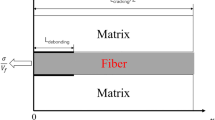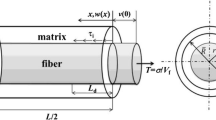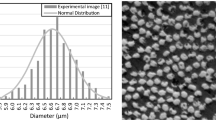Abstract
A comprehensive numerical analysis of micromechanical damage behavior in a continuous fiber-reinforced ceramic composite is presented. A three-dimensional micromechanical finite element modeling procedure is developed for effective elastic property estimation and damage evaluation by the example of a composite consisting of a silicon carbide matrix unidirectionally reinforced with silicon carbide fiber (SiC/SiCf). The effect of a fiber/matrix interface on predicted elastic properties of the SiC/SiCf composite is considered. Representative volume element (RVE) models are developed for an SiC/SiCf composite with damageable interfaces. Statistically equivalent RVE models with randomly distributed fibers are generated using a developed algorithm. The statistical variability of fiber and matrix strengths is considered in developing RVE models and assumed to follow a Weibull probability law. A user-material subroutine with an adaptive material constitutive law is developed to predict damage behavior in the RVE. The predicted uniaxial stress versus strain behavior and damage in the composite are discussed.
















Similar content being viewed by others
References
Wood K (2013) Ceramic-matrix composites heat up. High Perform Compos 21:38–45
Santhosh U, Ahmad J, Ojard G, Miller R, Gowayed Y (2016) Deformation and damage modeling of ceramic matrix composites under multiaxial stresses. Compos B Eng 90:97–106
Dassios K, Kostopoulos V, Steen M (2007) A micromechanical bridging law model for CFCCs. Acta Mater 55:83–92
Birman V, Byrd L (2000) Review of fracture and fatigue in ceramic matrix composites. Appl Mech Rev 53:147–174
Lissart N, Lamon J (1997) Damage and failure in ceramic matrix minicomposites: experimental study and model. Acta Mater 45:1025–1044
Curtin W, Ahn B, Takeda N (1998) Modeling brittle and tough stress-strain behavior in unidirectional ceramic matrix composites. Acta Mater 46:3409–3420
Curtin W (1993) Multiple matrix cracking in brittle matrix composites. Acta Metall Mater 41:1369–1377
Chateau C, Gelebart L, Bornert M, Crepin J, Caldemaison D, Sauder C (2014) Modeling of damage in unidirectional ceramic matrix composites and multi-scale experimental validation on third generation SiC/SiC minicomposites. J Mech Phys Solids 63:298–319
Xia Z, Zhou C, Yong Q, Wang X (2006) On selection of repeated unit cell model and application of unified periodic boundary conditions in micro-mechanical analysis of composites. Int J Solids Struct 43:266–278
Sun C, Vaidya R (1996) Prediction of composite properties from a representative volume element. Compos Sci Technol 56:171–179
Li S (2000) General unit cells for micromechanical analysis of unidirectional composites. Compos A Appl Sci Manuf 32:815–826
Xia Z, Chen Y, Ellyin F (2000) A meso/micro-mechanical model for damage progression in glass-fiber/epoxy cross-ply laminates by finite element analysis. Compos Sci Technol 60:1171–1179
Raghavan P, Moorthy S, Ghosh S, Pagano N (2001) Revisiting the composite laminate problem with an adaptive multi-level computational model. Compos Sci Technol 61:1017–1040
Xia Z, Zhang Y, Ellyin F (2003) A unified periodical boundary conditions for representative volume element of composites and applications. Int J Solids Struct 40:1907–1921
Drago A, Pindera M (2007) Micro-macromechanical analysis of heterogeneous materials: macroscopically homogeneous vs periodic microstructures. Compos Sci Technol 67:1243–1263
Evans A, Zok F, Davis J (1991) The role of interfaces in fiber-reinforced brittle matrix composites. Compos Sci Technol 42:3–24
Miriyala N, Liaw P (1996) The monotonic and fatigue behavior of CFCCs. J Mater 48:44–52
Mishnaevsky L, Brondsted P (2009) Micromechanisms of damage in unidirectional fiber reinforced composites: 3D computational analysis. Compos Sci Technol 69:1036–1044
Wang H, Qin Q, Zhou H, Miao H (2011) Damage progress simulation in unidirectional composites by extended finite element method (XFEM). Adv Mater Res 152–153:73–76
Bheemreddy V, Chandrashekhara K, Dharani L, Hilmas G, Fahrenholtz W (2012) Three-dimensional micromechanical modeling of continuous fiber reinforced ceramic composites with interfaces. In: Proceedings of ASME, November 9–15, Houston, pp 1–10.
Sever J, Nathal M, DiCarlo J (2013) Research on high-temperature aerospace materials at NASA glenn research center. J Aerosp Eng 26:500–514
DiCarlo J, Yun H, Morscher G, Bhatt R (2004) SiC fiber-reinforced SiC matrix composites for thermostructural applications to 1200 C and above. In: Bansal N (ed) Handbook of ceramic composites. Kluwer Academic Publishers, Boston, pp 77–98
Katoh Y, Ozawa K, Shih C, Nozawa T, Shinavski R, Hasegawa A, Snead L (2014) Continuous SiC fiber, CVI SiC matrix composites for nuclear applications: properties and irradiation effects. J Nucl Mater 448:448–476
Ivekovic A, Novak S, Drazic G, Blagoeva D, Gonzalez de Vicente S (2013) Current status and prospects of SiCf/SiC for fusion structural applications. J Eur Ceram Soc 33:1577–1589
Ismar H, Streicher F (1999) Modeling and simulation of the mechanical behavior of ceramic matrix composites as shown by the example of SiC/SiC. Comput Mater Sci 16:17–24
Yang L, Yan Y, Ran Z, Liu Y (2013) A new method for generating random fiber distributions for fiber reinforced composites. Compos Sci Technol 76:14–20
Wang Z, Wang X, Zhang J, Liang W, Zhou L (2011) Automatic generation of random distribution of fibers in long-fiber-reinforced composites and mesomechanical simulation. Mater Des 32:885–891
Liu S, Zhang L, Yin X, Cheng L, Liu Y (2011) Microstructure and mechanical properties of SiC and carbon hybrid fiber reinforced SiC matrix composite. Int J Appl Ceram Technol 8:308–316
Barbero EJ (2013) Finite element analysis of composite materials using Abaqus. CRC Press, Taylor & Francis Group, Boca Raton
ABAQUS/Standard User’s Manual, Vol. I and II (ver. 6.12) (2012) Hibbit, Karlsson and Sorensen, Inc., Pawtucket, Rhode Island
Chamis C (1984) Simplified composite micromechanics equations for hygral, thermal, and mechanical properties. SAMPE Q 15:14–23
Chawla KK (2003) Ceramic matrix composites, 2nd edn. Kluwer Academic Publishers, Norwell
Acknowledgements
This project was funded under Subcontract 10-S568-0094-01-C1 through the Universal Technology Corporation under prime Contract Number FA8650-05-D-5807. The authors are grateful for the technical support on the program by the Air Force Research Laboratory (AFRL) and specifically to Dr. Mike Cinibulk at AFRL for both his collaboration and guidance.
Author information
Authors and Affiliations
Corresponding author
Rights and permissions
About this article
Cite this article
Bheemreddy, V., Chandrashekhara, K., Dharani, L.R. et al. Computational study of micromechanical damage behavior in continuous fiber-reinforced ceramic composites. J Mater Sci 51, 8610–8624 (2016). https://doi.org/10.1007/s10853-016-0120-4
Received:
Accepted:
Published:
Issue Date:
DOI: https://doi.org/10.1007/s10853-016-0120-4




